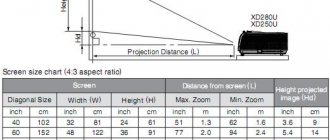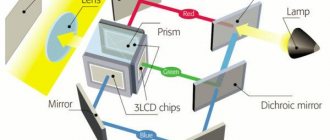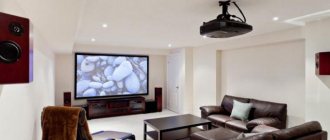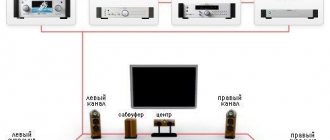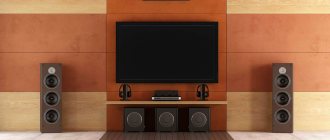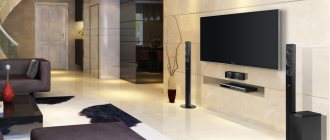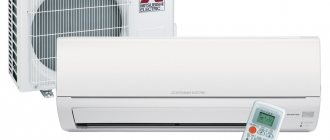Let’s immediately talk about what prompted me to write the article: for many, the word “projector” is strongly associated with a bulky unit for school, holding lectures at the institute, showing slides and monotonous presentations.
But time does not stand still, and a modern projector can easily be turned into a full-fledged home entertainment center (or a key part of it).
And they decided to demonstrate the capabilities of projectors in an unusual way - by dispelling the seven most popular myths that often stop buyers from purchasing projector equipment for their home. Go.
Home projectors do not produce high-quality images in a bright room
Many people fear that the projector will be of little use within their own four walls, they say, the picture will be faded and all that.
A very one-sided statement. It would be correct to say that not all projectors are equally good in a bright room. How do you know if the projector model you like is suitable for a bright living room? Quite simple - just find in the characteristics such a parameter as brightness .
Projectors with brightness levels of 2,000 lumens and above are specifically designed to work in moderate light conditions. The brighter the room, the higher the brightness should be - then the picture will be juicy and clear. A very good option is a projector with a brightness of around 3000 lm. The brightness of such a projector is enough even with a reserve.
Projectors with a brightness of 1500 lumens and below will perform better in a specially prepared darkened room, which is often called a “home theater.” Familiar name, right?
For example, the Epson EH-TW5400 home projector produces an image with a brightness of 2500 lumens and Full HD resolution. Combined with a high contrast ratio of 30,000:1, this results in a bright image with deep blacks in the dark, or just a bright image in a bright room.
PS By the way, another opportunity to increase the brightness of the picture during the day is to use a special reflective screen (you can make one yourself). There are many videos on Youtube dedicated to this topic, but as they say, this is optional.
Types of projectors for home and office
There are several classifications of projection technology. By purpose they are distinguished:
- A presentation projector is the most common type of device on the market. They can be found in offices, classrooms, and conference rooms. These rooms are usually well lit. Therefore, the presentation projector is designed to produce a clearly visible image in conditions of intense external light. This technique is characterized by high brightness of the output image. But contrast and color display quality are not the strongest aspects of an office projector. A big plus is that the office projector is a fairly compact device that can be easily moved from office to office;
socket.by
975.5 rub.
All stores (16)
ViewSonic PA503S projector
from 901 to 1231 rub.
Presentation, portable, DLP, matrix resolution 800×600, brightness 3600 lm, contrast 22000:1.
Description Where to buy (16)
- home theater projector - designed for use with the lights off. In the dark, high brightness is not needed - in this parameter it is many times inferior to presentation ones. But a home theater projector provides much higher contrast and color quality;
socket.by
1459 rub.
All stores (11)
Xiaomi Mi Smart Compact Projector M055MGN
from 1399 to 1599 rub.
For home cinema, portable, DLP, matrix resolution 1920×1080, brightness 500 lm, contrast 1200:1.
Description Where to buy (11)
socket.by
3336 rub.
All stores (11)
Projector Epson EH-TW5820
from 2950 to 3873.48 rub.
For home cinema, portable, 3LCD, matrix resolution 1920×1080, brightness 2700 lm, contrast 70000:1.
Description Where to buy (11)
- professional projector - most often this is a rather bulky device that is permanently installed in large conference rooms. Such a device produces enormous brightness and can form an image with a diagonal of several meters.
By size, home and office projectors are divided into:
- stationary - have high technical characteristics: powerful luminous flux, high resolution, you can change the optics and simultaneously reproduce a signal from several sources. Not intended for frequent movement;
- portable - more compact than stationary ones, can be easily moved from room to room. They have high resolution and luminous flux. Most often used to display presentations. They can be found in offices and educational institutions. The portable projector can be mounted under the ceiling and used as a stationary one;
socket.by
1668 rub.
All stores (15)
Projector Epson EB-W06
from 1515 to 1946.55 rub.
Presentation, portable, 3LCD, matrix resolution 1280×1080, brightness 3700 lm, contrast 16000:1.
Description Where to buy (15)
- ultraportable - lightweight and compact models. The main scope of application is business presentations;
- pocket - weigh only 200-300 grams and literally fit into your pocket. A mini projector is used when you need to make an unplanned presentation, for example, on business trips, etc.
It is impossible to understand the technologies of a modern projector
It's all too complicated (not really).
Today, the oldest electron beam imaging method is practically not used in projectors; several technologies have come to replace it:
- Translucent liquid crystals (3LCD technology). Projectors provide good image brightness and a large number of colors.
- Micromirrors (DLP technology). Projectors produce images with high contrast and emphasize black, often to the detriment of color quality.
- Liquid crystals for reflection (LCOS, D-ILA, SXRD, 3LCD Reflective technologies). Projectors create a bright picture with high contrast, but are not very affordable in price.
As a result, if you really evaluate the purchase of a projector for your home, there are two technologies in use: 3LCD and DLP. The main difference is in the principle of image formation. Here is a fairly clear video that talks about the advantages and disadvantages of each technology.
Projectors require the purchase of additional acoustics
Are projectors a lot of extra expenses?
It all depends on personal preference. For some, it will be enough to have built-in sound, which is found in most projectors, except for installation and premium home ones. Most often we are talking about one speaker with a power of 2 to 16 watts. An example is the Epson EH-TW6700, it has built-in stereo speakers at the back of the case.
And give someone high-quality acoustics. Such buyers often already have a good understanding of the topic, so in this post we are definitely not advisors to them when it comes to sound.
Advantages of a film projector compared to a TV
- Watching a movie on a large screen provides a more vivid experience, and the cost of a large screen is disproportionately small compared to a TV with a diagonal of more than 2 meters.
- The strain on your eyesight is not as great as when watching TV. The difference is that the light emanating from the projector is directed at the screen and enters the viewer's eyes in a reflected form. This is a “system” familiar to our eyes. Everything that our eyes see, they see thanks to reflected rays. If we look at a direct light source, as in the case of a TV, it causes more strain on the visual organs.
- Ability to dynamically change the screen format: 21:9, 16:9, 4:3. View images of any of the listed formats in full form.
- The projection equipment is compact and does not require much space to install. Therefore, it does not conflict with any interior.
Adjusting the projector to your room is a real headache
Do you need a room with ideal dimensions?
Most projector models have a decent level of zoom (read: change in focal length), which allows you to match the size of the projection to the parameters of the screen without moving the projector closer or further from the wall. Additionally, some projectors have flexible manual lens shift adjustments. There are also those that are equipped with automatic vertical geometry correction.
This gives greater freedom in image adjustments.
For example, with the same Epson EH-TW6700 you can get a geometrically correct image on the wall in less than a minute, using a wide range of lens shift, optical zoom, vertical and horizontal keystone correction.
And there is also a type of projector that is placed directly next to the wall. For example, the Epson EH-LS100 ultra-short throw laser, when installed on a stand, will create an image with a diagonal of 90 inches at a distance of only 53(!) cm from the wall.
If anything, Epson has a projection calculator that allows you to estimate the parameters of the projector and “try on” it for your room.
Watching a movie from a laptop on a projector is a problem
Many are sure that before a film screening there will be a dance with tambourines.
Modern projectors can be easily connected to your home network, and some models also support wireless connections. Those. Not only any computer from the network, but also mobile devices and game consoles can be easily connected to the projectors, from where you can display photos or video content, and, of course, play on the big screen. In addition, an increasing number of projectors have the ability to connect USB flash drives.
Normal projectors cost a fortune
One of the most common myths.
In fact, the prices of modern mass-produced projectors are quite comparable to TVs of smaller diagonals.
For example, the universal projector EH-TW610 with HD resolution (1920×1080), brightness of 3000 lumens, and the ability to transmit images via a wireless Wi-Fi network costs around 47,000 rubles. The lamp life of this model, in particular, allows you to watch a movie every day for 11 years.
It should be remembered that a projector is a universal solution. It is enough to move it away from the wall (or turn the zoom lever) to get an image of the diagonal that is required, at least one hundred, at least two hundred inches or higher. This won't work with TV. Well, you can estimate the cost of TVs with a diagonal of 80+ inches on any price aggregator.
In short - no. They haven't been standing for a long time.
Pros and cons of using a projector for everyday viewing
There are various reasons why using a projector for everyday viewing is either a great or not a good idea. This depends on the room the projector may be placed in, the people watching, and more!
Pros of using a projector for everyday viewing
Undeniable price advantage over major TV options
What's the best-selling and biggest TV you can buy on Amazon? At the time of writing, the LG 86UM8070PUA 86-inch 4K Ultra HD Smart LED TV (on Amazon) takes that crown and does so at a price of nearly two thousand dollars. This is a serious price, and there is no doubt that the TV will be about performance, picture quality, etc.
But here's the thing: this TV is still 14% smaller than a 100-inch screen, and a projector that can do that will cost half as much. Literally. The XGIMI H2 4K smartphones (on Amazon), for example, come in less than half the 86″ LG TV, and are designed for, not a 100-inch screen, not a 200-inch screen, but as much as a 300-inch diagonal projector screen.
If your goal is big, there is no doubt that projectors have the advantage. And if you're already sold, you can check out some of our projector recommendations here, but keep reading to learn more about the pros and cons.
Impressive user experience
A larger screen simply makes the video more attractive. Whether it's the news, sitcoms, or a blockbuster movie, having a huge screen on which to watch all your "normal" content makes it all more fun. It takes a part of your life—perhaps the weekly ritual of watching your favorite shows—and turns the experience into something more meaningful.
A surprising benefit is that a larger screen is actually easier on the eyes as it takes up more of the field of view, simulating how light works in the real world. If you watch a lot of TV and suffer from eye strain, upgrading to a projector can solve these problems.
Cons of using a projector for everyday viewing
Projectors have higher running costs due to lamp life
The typical projector lamp life is around 2000 hours, which will be fast if you use the projector for everyday TV viewing. Specifically, if you're the type of person who leaves the TV on in the background while getting ready in the morning and then again all evening, you can probably work 8 hours a day, which adds up to 2000 hours in just 250 hours. days.
Not even a whole year. However, the projector industry, and especially high-end projectors like the one listed above, are moving away from traditional incandescent lamps with a short lifespan to long-lasting LED lamps.
This increases the lamp life by an order of magnitude. In the above example, the XGIMI H2 lamp life is 30,000 hours. With our metric of 8 hours a day, that’s a cool 10 years. So, if you purchase a projector with LED backlighting, this “minus” may be completely irrelevant.
And there may be another hidden benefit here: a projector is probably a little cheaper to run compared to a TV. There's also more about it in our article here if you're interested.
It can actually be difficult to install a TV on your projector
For streaming services that run as apps or as streaming sticks, there are usually fairly simple solutions for getting content on your projector: whatever box you use to run your setup (maybe it's a PC or an Xbox), you can almost always just download Netflix or Hulu and get going.
However, for traditional TV channels that you buy from a cable company, there may be a few more problems. If your cable box must be tethered to a wall where it can access an Ethernet or cable jack, placement becomes an issue. If you are installing a cable box on the projector, you will need to run a cable line to it.
If you place the cable box next to the jack, you now need to run HDMI from the projector back to that location. Using a wireless HDMI kit can easily solve this problem for you, or you can get a wireless cable box from your provider. However, this is definitely an extra step that you may need to consider if you want to watch regular TV on a projector.
More complex sound settings
TVs almost always have built-in speakers that are sufficient for everyday use. Projectors... not so many. When they do have speakers built-in, they are often cheap-sounding with tinny highs and non-existent lows.
If the TV is wide enough to have left and right audio speakers, the projector not only doesn't have the width to play with, but it's often mounted above you rather than on the video surface, making using the projector's built-in audio obsolete. fast.
This means you'll need to solve your audio problem with a projector, which you won't have to bother with at all if you're using a TV.
You can't watch high-quality video on a projector
And 3D too.
Now the market is full of models with a resolution of 1280 x 720 and Full HD devices with matrices with a resolution of 1920 x 1080 pixels. For example, the “HD Ready” marking on projectors is a sign of the quality of devices capable of processing and displaying High Definition signals.
But you need to remember that resolution directly affects the clarity of the image. Therefore, for screen sizes of at least 3 m wide, it is recommended to use projectors with a resolution of at least Full HD, since only they can provide a detailed image over a large screen area.
Most modern projectors are capable of converting standard 2D video to 3D format. And most projectors are able to display content in 3D mode thanks to their high brightness reserve (because it’s no secret that with 3D glasses, the brightness of the picture is noticeably reduced, so you need to compensate).
How to choose a home projector
Here are some tips that you should listen to before buying a projector for your home.
socket.by
2427.88 rub.
All stores (11)
Xiaomi Mi Smart Projector 2 Pro
from 2299 to 2676.49 rub.
For home cinema, portable, DLP, matrix resolution 1920×1080, brightness 1300 lm, contrast 1200:1.
Description Where to buy (11)
Room area
This is perhaps the first place to start. The technical data sheet of each projector indicates an important parameter - “throw ratio”. It is understood as the distance from the projector to the screen on which its light falls, divided by the width of this screen. Projectors with a high level of this parameter are called long-focus. This means that they can provide a good image at a considerable distance from the screen. For example, a long throw projector can create a 2 m wide image while being 4 meters from the screen. Therefore, such a device is usually purchased for spacious rooms: university classrooms, conference rooms, etc. A short throw projector is installed much closer to the screen. This technique is best suited for home use.
There are also ultra short throw projectors. They can be installed very close to the screen (up to 20 cm). In this case, the image turns out to be quite large. Ultra short throw projectors are great for showing presentations in small spaces. But they will cost more than others due to more technologically advanced optics.
socket.by
2586 rub.
All stores (15)
Projector Epson EB-FH06
from 2227 to 3164 rubles.
Presentation, portable, 3LCD, matrix resolution 1920×1080, brightness 3500 lm, contrast 16000:1.
Description Where to buy (15)
Some projectors allow you to change optics, turning from long throw to short throw and vice versa.
Permission
The resolution of projectors refers to the number of dots that can be displayed on the screen. The higher the resolution, the better the quality of the picture. It is better not to take projectors with a resolution of 800x600 and 1024x768 for home use. The purpose of such equipment is office presentations, but films will not please you with good detail.
socket.by
3624 rub.
All stores (13)
Projector Epson EB-FH52
from 2624 to 3624 rub.
Presentation, portable, 3LCD, matrix resolution 1920×1080, brightness 4000 lm, contrast 16000:1.
Description Where to buy (13)
The most common resolution indicators for home theater projectors are:
- 1280x720 is the preferred option for budget projectors, which will allow you not to overpay for unnecessary functions;
- 1280x768 is a good choice for home theater;
- 1920x1080 - will allow you to get a rich picture.
Aspect Ratio
This is the proportion of the length and width of the image projected onto the screen.
- 4:3 - suitable for presentations in the office;
- 16:9 is an ideal setting for playing widescreen video. The best choice for home cinema.
Contrast
Contrast is the ratio of the brightness of white and black colors on a screen. The higher the contrast ratio, the more black looks like black rather than gray. Therefore, more details can be seen on the screen. The manufacturer indicates the so-called contrast ratio. For example, a ratio of 1500:1 means the projector displays white 1500 times brighter than black. However, there is an important nuance: the manufacturer determines the contrast ratio in laboratory conditions, i.e. in complete darkness. The more extraneous light there is in the room, the lower the actual contrast. If you need a projector for an office, then you can ignore the contrast: in well-lit rooms, dark areas of the image will still be overexposed. It's another matter if you plan to buy a projector for a home theater. Here contrast is the most important parameter.
Projector brightness
Unlike a TV, the brightness of a projector is a rather arbitrary characteristic. It depends more on the screen parameters (size, material, color), room lighting and many other factors. Therefore, the data sheet does not indicate brightness, but luminous flux. Luminous flux is the power of light emitted by a projector. It is measured in lumens (lm). It is believed that a 1000 lm projector is sufficient for viewing in the dark. An office projector operating in bright conditions should produce at least 2000 lumens. Most modern projectors allow you to select an image output mode - that is, adjust the balance between brightness and color reproduction.
socket.by
3683.52 rub.
All stores (15)
BenQ W1720 Projector
from 3308 to 4687 rub.
For home cinema, portable, DLP, matrix resolution 3840x2160, brightness 2000 lm, contrast 10000:1.
Description Where to buy (15)
Power
When choosing a multimedia projector, you should pay attention to the lamp power. The higher it is, the brighter the projected image will be. In modern projectors, the lamp power can be from 40 to 20,000 W.
Bonus myth No. 8: With this article you want to “sell Epson projectors to readers”
Let's be honest: the Epson brand has been producing its devices for several decades, and they sell absolutely wonderfully precisely because they “deliver” what the manufacturer promises: high brightness and a rich, large-diagonal picture for a reasonable price (plus all sorts of additional features, if required) .
Of course, it is up to the reader to decide which projector to choose.
Our job is to tell you that a modern projector is not a “slide projector from the times of the USSR”, but a multimedia device that, for the right price, allows you to get a diagonal screen even the size of an entire wall. Suddenly: it so happened that Epson and the online cinema ivi.ru are conducting a joint campaign “Subscription to your personal cinema ivi”. When you purchase an Epson home projector, you can get a 6-month unlimited movie .
It's a small thing, but nice. So, good luck with your choice and enjoy watching!
( 7 votes, overall rating: 4.29 out of 5)

